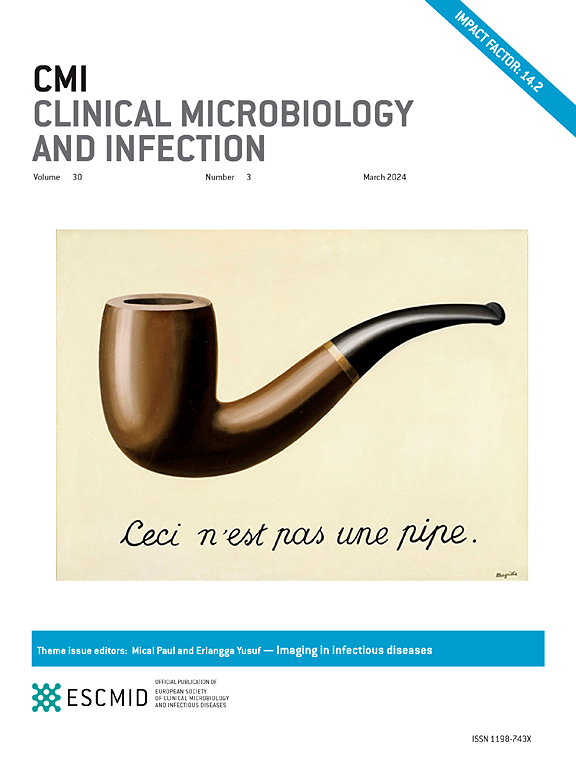低流行率地区的社区 MRSA 爆发。
IF 10.9
1区 医学
Q1 INFECTIOUS DISEASES
引用次数: 0
摘要
目的:本综述旨在探讨低流行率地区社区获得性耐甲氧西林金黄色葡萄球菌(CO-MRSA)爆发的特点,了解其上升的相关因素,并将这些知识转化为公共卫生政策和进一步的研究需求:使用 "传播"、"获得"、"CA-MRSA"、"MRSA"、"社区获得性"、"低流行率"、"基因组"、"爆发"、"定植 "和 "携带 "等术语组合检索了 PubMed、EMBASE 和 Google Scholar。在证据有限的情况下,通过 PubMed 搜索专门查找其他文章。未提供英文资料的论文被排除在外:社区获得性、社区发病的 MRSA 感染是一项重大的公共卫生挑战,即使是在 MRSA 感染率历来较低的低流行地区也是如此。尽管在减少医院发病的 MRSA(HO-MRSA)方面取得了成功,但社区发病的 MRSA 感染率在全球范围内仍在上升,因此有必要了解这一趋势以及重新出现的潜在风险因素。本文讨论了界定低流行地区所面临的挑战,以及暴露于各种社区感染风险因素(如医疗机构、旅行、牲畜和环境因素)的重要性。此外,还强调了基因组监测在确定疫情菌株和了解传播动态方面的重要性,以及制定强有力的公共卫生政策和控制措施的必要性:研究结果强调了 CO-MRSA 传播的复杂性,以及在低流行地区采取多方面方法的必要性。这包括对HO-、CO-和家畜相关MRSA(LA-MRSA)进行综合、系统的监测,这在一些北欧国家非常有效。CO-MRSA 的演变凸显了全球合作、常规基因组监测和全面抗菌药物管理的必要性,以缓解 CO-MRSA 的上升并应对更广泛的抗菌药物耐药性挑战。这些努力对于在低流行率地区和高流行率地区保持较低的 MRSA 流行率和控制 CO-MRSA 不断增加的负担都至关重要。本文章由计算机程序翻译,如有差异,请以英文原文为准。
Community methicillin-resistant Staphylococcus aureus outbreaks in areas of low prevalence
Background
Community-acquired (CA), community-onset methicillin-resistant Staphylococcus aureus (CO-MRSA) infection presents a significant public health challenge, even where MRSA rates are historically lower. Despite successes in reducing hospital-onset MRSA, CO-MRSA rates are increasing globally, with a need to understand this trend, and the potential risk factors for re-emergence.
Objectives
This review aims to explore the characteristics of outbreaks of community-acquired community-onset methicillin-resistant Staphylococcus aureus in low-prevalence areas, to understand the factors involved in its rise, and to translate this knowledge into public health policy and further research needs.
Sources
PubMed, EMBASE, and Google Scholar were searched using combinations of the terms ‘transmission’, ‘acquisition’, ‘community-acquired’, ‘MRSA’, ‘CA-MRSA’, ‘low prevalence’, ‘genomic’, ‘outbreak’, ‘colonisation’, and ‘carriage’. Wherever evidence was limited, additional articles were sought specifically, via PubMed searches. Papers where materials were not available in English were excluded.
Content
Challenges in defining low-prevalence areas and the significance of exposure to various risk factors for community acquisition, such as healthcare settings, travel, livestock, and environmental factors, are discussed. The importance of genomic surveillance in identifying outbreak strains and understanding the transmission dynamics is highlighted, along with the need for robust public health policies and control measures.
Implications
The findings emphasise the complexity of CO-MRSA transmission and the necessity of a multifaceted approach in low-prevalence areas. This includes integrated and systematic surveillance of hospital-onset-, CO-, and livestock-associated MRSA, as has been effective in some Northern European countries. The evolution of CO-MRSA underscores the need for global collaboration, routine genomic surveillance, and comprehensive antimicrobial stewardship to mitigate the rise of CO-MRSA and address the broader challenge of antimicrobial resistance. These efforts are crucial for maintaining low MRSA prevalence and managing the increasing burden of CO-MRSA in both low and higher prevalence regions.
求助全文
通过发布文献求助,成功后即可免费获取论文全文。
去求助
来源期刊
CiteScore
25.30
自引率
2.10%
发文量
441
审稿时长
2-4 weeks
期刊介绍:
Clinical Microbiology and Infection (CMI) is a monthly journal published by the European Society of Clinical Microbiology and Infectious Diseases. It focuses on peer-reviewed papers covering basic and applied research in microbiology, infectious diseases, virology, parasitology, immunology, and epidemiology as they relate to therapy and diagnostics.

 求助内容:
求助内容: 应助结果提醒方式:
应助结果提醒方式:


